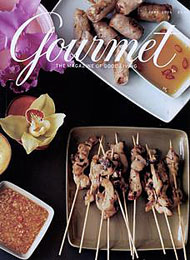'Food and Culture' spices up Short Term

"Food and Culture," conceived and launched by historian Fiona Halloran, was one of some two dozen new Short Term courses in 2006.
As a visiting professor at Bates for the 2005-06 year, historian Fiona Halloran mostly taught prescribed courses during the fall and winter semesters.
But for Short Term, “the College felt I could teach what I wanted,” she said. “That opportunity made me want to teach ‘Food and Culture.’ A session like Short Term makes room for a course that’s outside the normal bounds.”
In the spring, Halloran spoke with staff writer Doug Hubley about her new course, which focused on food writing, expecially on authors M.F.K. Fisher, Julia Child and James Beard and magazines like Gourmet, as a way to explore connections between food and American identity and culture.
DH: Tell me how your research led you to develop this course.
FH: My specialty is 19th century American political history, so “Food and Culture” is a total departure from the research I do most of the time. But, like most people’s research, this has ties to what interests me personally and to things you bump into doing any research.
DH: What sort of topics did you bump up against?
FH: In researching colonial history, you always can read about Englishmen in America having an incredibly hard time just feeding themselves. Or about their anger and disdain at the concept of eating corn instead of wheat. Or their incredible, insatiable appetite for sugar, chocolate and coffee in the 18th century and the effect that has on worldwide trade and slavery. Then in the 19th century, there are issues around food and immigration: about what immigrants eat, about immigrants not having enough to eat, about anxieties around the emerging American world and how to feed the cities. I did my dissertation on political cartoonist Thomas Nast, and the first crusade he went on was against police corruption. The second was against adulterated milk in New York, nasty stuff that killed children.
DH: What interests you personally?
FH: I’ve always loved Julia Child and M.F.K. Fisher, and we are living in a time when people are focused on the preparation of food and concerned about food purity, food origin and the effects of food on the body. Eventually you finally think, “I’m going to exorcise this demon by just throwing a class!”
DH: Are you going to be dealing with the way that authors like M.F.K. Fisher elevated food from the commonplace?
FH: We’re going to read Fisher’s The Gastronomical Me. What she basically says in the introduction is that she is really not writing about food but the things people need and the ways they fulfill those needs. And that’s why many of her stories, which people love because of the food in them, are really about desperation and loneliness and tragedy and things like that.
My interest in the students reading MFK Fisher, Child and James Beard is to see how these writers focus on American identity and the question of human needs and how they can be satisfied with foods. If you look at all three of them, what you find is this quest to figure out who you are and to assuage your pains. James Beard was gay and grew up in this very discombobulated home environment; he finds his place in the world in part by satisfying himself and satisfying other people through food and writing. Julia Child leaves Pasadena, and in this attempt to enter the world of her much-older and more sophisticated husband, trains herself to become a culinary expert in order to become, essentially, French.
There is often a sense that the 1950s are all about conformity. But throughout the ’50s, there is this undercurrent of folks who are dissatisfied with TV dinners and Eisenhower, and those people are in some ways represented by Julia Child, M.F.K. Fisher and James Beard, who are building up what is to come: an embrace of the international in the ’60s.
DH: How does a course like this help students think like historians?
FH: Students learn to pursue alternative evidence forms. Students don’t often think, for example, about the fact that elite New York women in the 19th century are happy to have an Irish maid and cook but would never eat cabbage and boiled ham. They would consider that disgusting peasant food. So I might ask a student, “Have you considered looking at menus? Have you considered looking at grocery records? Have you considered looking at plays and looking for discussions around these things?” It’s possible to look in art, literature, furniture, food, clothing and all of sorts of other places for historical evidence.
 DH: Gourmet is an interesting choice because it’s so narrowly targeted to a particular socio-economic group.
DH: Gourmet is an interesting choice because it’s so narrowly targeted to a particular socio-economic group.
FH: Unlike an academic journal, a magazine like Gourmet is an organ of our culture, so it reflects back to students something they have to interpret. Students in this particular class get to see how a certain group changes over time, which is sort of the basic definition of history. Say you start with a group of people in 1948, and through the lens of Gourmet you look at the foods they want to eat and the cultures they consider sophisticated. In 1948, it was all about France. In 2004, it’s all about Asia. What does that say about changes in culture, about who Americans think they want to be like? What does it say about availability — like, can you get lemongrass in Kansas? Well you can, and that’s pretty amazing.
DH: What else is on the reading list?
FH: I use a set of Time Life Foods of the World books, produced by a whole corporation basically dedicated to telling the middle class what it wants to hear. The ones I use were created in the ’60s and ’70s, so the one dealing with Russia has commentary about national politics and about various issues related to that. The ones about the American South and about the Caribbean have a lot of commentary about race. And in a number of cases they can be well intentioned but deeply ham fisted in those regards. It’s interesting to wonder what this tells you about changes in the middle-class culture in America.
We also read about food and the cost to our society and ourselves, so they are reading the most recent combination of scandalous food books, like Fast Food Nation, and they are watching Supersize Me to spur them to talk about food in the modern era. Fast Food Nation is really a book about labor, so it’s like reading about sugar in the 18th and 19th centuries except now it asks where potatoes come from at McDonald’s. It used to be that there were 25 varieties of commercial potatoes available, but now there are just two because those are the ones McDonald’s wants.